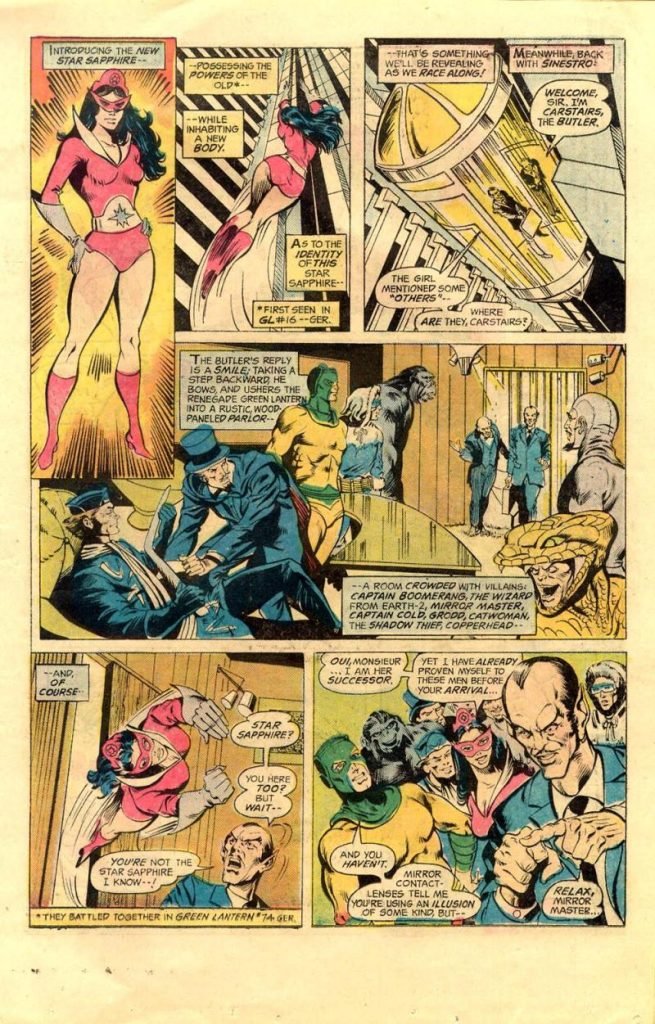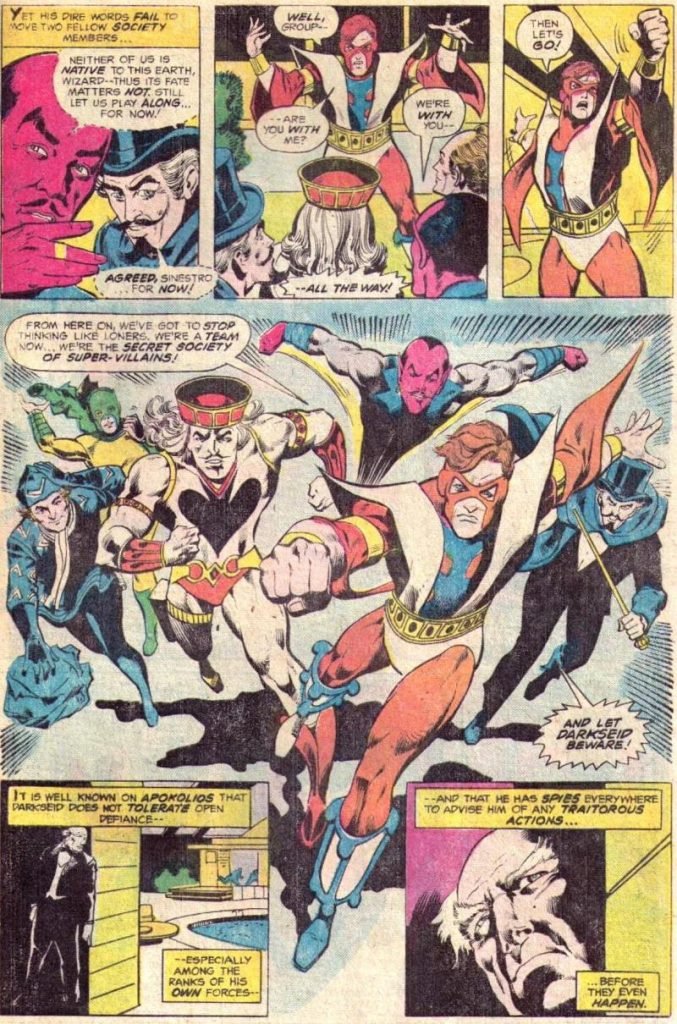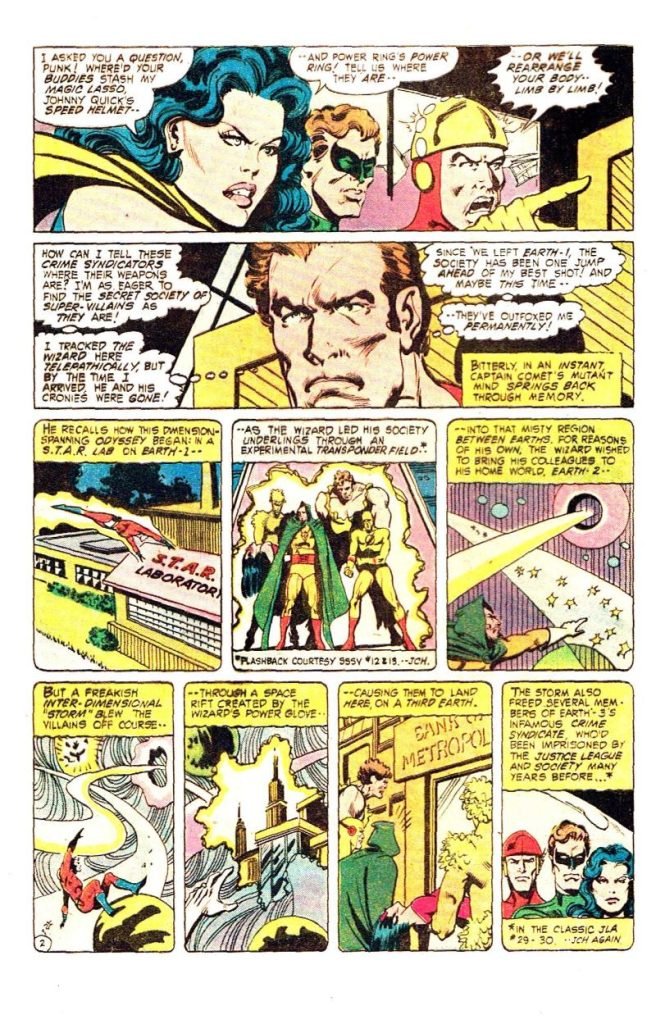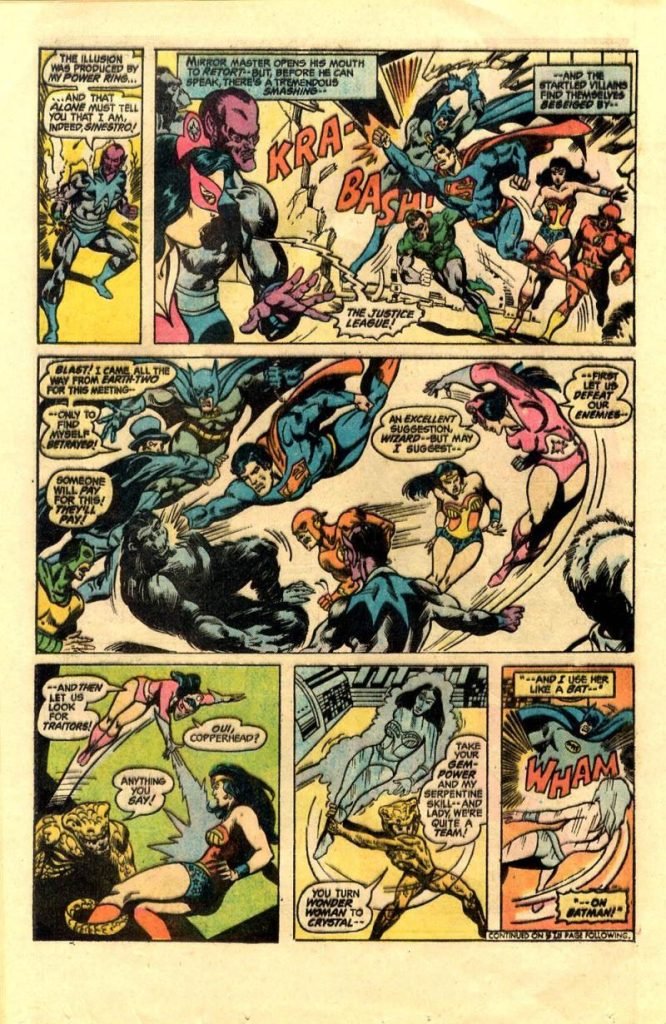Writers: Gerry Conway, David A. Kraft, Bob Rozakis
Artist: Pablo Marcos, Vince Colleta, Ernie Chua, Rich Buckler, Bob Layton, Dick Ayers, Jack Abel, Joe Orlando, Mike Vosburg, Bob Smith, Bob McLeod
DC Comics, May/June 1976 – June/July 1977

The subversion of DC Comics’ title The Secret Society of Super-Villains, published between 1976 and 1977, requires context.
The Comics Code Authority (CCA) was an organisation established in the United States in 1954 by the Comics Magazine Association of America (CMAA). It self-regulated the content of comic books published within the United States. The CCA was created in response to highly politicised concerns about the content of comic books, particularly regarding violence, horror, and other potentially harmful themes. The CCA developed a set of guidelines called the Comics Code. Publishers had to adhere to the Comics Code if they wanted their comics to carry the CCA’s seal of approval. The seal was an ubiquitous feature on American comic books from the 1950s to the 1990s:

The Comics Code was designed to ensure that comic books did not glorify or overly sensationalise criminal behaviour or villainous acts, particularly in a way that might be harmful to young readers (who, at that stage, were the primary audience of American comic books).
Villains were a focus of the Comics Code. Some specific aspects of how the Comics Code treated villains included:
- Crime and violence: The Comics Code discouraged the portrayal of criminal acts in a positive or glamorous light. This meant that villains could not be depicted as successful or rewarded for their crimes, and any violence depicted had to be presented in a way that did not glamorise it.
- Morality and authority figures: The Comics Code required that authority figures, such as law enforcement or parental figures, be depicted as morally upright and ultimately triumph over villains. Villains were typically shown facing consequences for their actions: justice must prevail.
- Drug use: The Comics Code explicitly prohibited the portrayal of illegal drug use or addiction. This meant that villains could not be shown using drugs or engaging in drug-related activities, as such content was deemed inappropriate for young readers. Green Arrow’s sidekick Speedy was depicted using heroin in Green Lantern / Green Arrow #85 in 1971 – but that issue inexplicably featured the Comics Code seal.
And so, in that context, in 1976, American publisher DC Comics under the auspices of its new general manager, Janette Kahn, launched this new title, The Secret Society of Super Villains. Setting aside complications with the Comics Code, this title was very much against the grain. Other superhero titles such as Marvel Comics’ title Heroes for Hire explored motivations other than the typical altruism of the likes of Superman and Spider-Man. But this was completely different. The Secret Society of Super Villains consisted overwhelmingly of a cast of characters who were not at all motivated by the desire to do good in the world. They were almost all villains, through and through. Here is a table of the highly variable cast:


Only issues 9 and 14 did not have an antagonist arriving or leaving the title – a dizzying circus ride of characters.

And those villains did not have like-minded drivers. Some of them were urged to do well by a lust for power, such as the Wizard. Others like Copperhead and Star Sapphire were in it for wealth. Blockbuster repeats a mantra – a promise of death to Batman. The Flash’s arch-nemesis Professor Zoom wants to conquer the world. The Plant Master was even more extreme, out to transform humanity into plant creatures like himself. We are used to the idea of characters with different motives in contemporary times, particularly having regard to the success of John Ostrander’s Suicide Squad in the 1990s. But two decades before, writers Gerry Conway, Bob Rozarkis and David Kraft were exploring a large number of characters did not want to be even vaguely perceived as doing good.

Initially, the Society is put together by long-standing DC villain Darkseid, although he remains in the shadows as a mysterious benefactor to the initially quite large ensemble. Foremost amongst the cast in the first four issues is Manhunter, or rather, a clone of the character who appeared in the acclaimed back stories of Detective Comics in 1974-5, written by Archie Goodwin and drawn by Walt Simonson. (The clones of the original Manhunter were the minions of a cabal, each trained in martial arts. Most of them ended up dead at the hands of the original Manhunter.) Here, a Manhunter clone who has wandered out of the Detective Comics storyline, and decided to amend his ways. The Manhunter clone has ambitions of assassination. He is killed when, wearing concealed bombs, he endeavours to (unsuccessfully) murder Darkseid just as the master villain beats a retreat back to his home planet.

Later, out of the pages of The Flash, the villainous Trickster appears. The Trickster is initially out for money, and later out for revenge, ultimately disappearing from the plot when he decides that his life might be in danger because the Society members play too rough.
One of the lead characters is Gorilla Grodd, another long-time opponent of the Flash, who, as with the rest, seems to have his own mysterious agenda (never revealed).
The Wizard, an old foe of the Justice Society of America, finds himself with waning magical powers, and so manipulates the Society into procuring for him a series of mystical artefacts, which he then uses to lead the Society.

Another character who appears unexpectedly is the Creeper. The Creeper is regarded by most of the world of the DC universe, at the time, as a villain. The Creeper is secretly a reporter named Jack Ryder, who has the ability to transform himself into a cackling yellow skinned monster.


The Creeper plays along with the society when he is recruited, and find himself needing to pull his punches – Star Sapphire notices that the Creeper seems “hesitant“. The Creeper eventually loses the trail of the Society and heads back to Gotham City.

Towards the end of the series, the Society launches a raid on the interdimensional parallel world Earth 2, and Star Sapphire attacks the Wizard after finding she has been shanghaied into his mission.

With myriad motivators at play, this Society often finds itself in internecine conflict. The dialogue is stilted but entertaining: the Society members constantly squabble with each other with a ferocity which a reader in 1976 would never have seen in the pages of Justice League of America or The Avengers. There is frequently tense acrimony between the members in respect of who should lead, what their collective objectives are, and who should even be a member of the organisation. (In that regard, the Society sounds like a board of ambitious directors of a large corporation. They even have their headquarters in a large office building in the San Francisco business district.)

The Wizard is ruthless in his overthrow of recidivist scammer Funky Flashman, and Lex Luthor is sold out to the police when he leaves the Society. Darkseid dispatches his soldiers Mantis and Kalibak to fight the Society in an early issue – but Sinestro and the Wizard hold back in the melee, not committed to risking their lives. The Society later fight to a standstill the Crime Syndicate of America, a squad of supervillains from a parallel world called Earth-3. The villains do not fight just superheroes: they fight other groups of villains, too.

Because the Comics Code could not permit a title consisting of nothing but villains, DC Comics brought back from obscurity a character called Captain Comet and inserted the character into the title. The character’s adventures had not been published for 20 years, and Captain Comet was reintroduced as having completed an extended mission in space. (Finding himself dressed in 1950s fashion in the mid-1970s is an amusing detail in the beginning of the title.) In what seems to us to be repeated breaches of the Comics Code, Captain Comet is often defeated by the Society. Nonetheless, adherence to the spirit of the Comics Code ensured that the Society were never completely triumphant. Other superheroes appear, too:

The Secret Society of Super Villains was a victim of the notorious DC Implosion. This was a rationalisation of DC Comics’ underperforming titles, and in in this instance, it led to the Society’s adventures being cut short. There was no conclusion to the adventures of the Society after issue 15. The final page promises yet more villains – Killer Moth, Chronos, Quakemaster, and the Sizematic Twns. But, without warning, the title ends.
The conclusion to the story is told in-continuity by the Wizard in the pages of Justice League of America #166 (1979), which has the Society on the run from Earth-2’s Justice Society of America:

But many of the titles which were cancelled during the DC Implosion had their final pages published in a comic book called Cancelled Comics Cavalcade. Black-and-white pages of these cancelled issues were circulated amongst industry professionals, and some have leaked out. As noted on the 13th Dimension website: AFTER THE IMPLOSION: Cancelled Comic Cavalcade | 13th Dimension, Comics, Creators, Culture
Bob Rozakis, then DC Comics assistant editor, in a comment posted on his blog in 2012:
From the rubble emerged Cancelled Comic Cavalcade, two blank-covered volumes of the material consigned to the filing cabinets. Ostensibly created to protect the copyrights on all the material, CCC was also a way for the fanboys on staff to create something of a collectible for the people who worked on the axed features.”
—
Paul Kupperberg, then DC Comics public relations assistant in an interview posted online in 2007:
I did the grunt work on [Cancelled Comic Cavalcade], assembling all the material from the various editors, arranging it all, and dealing directly with the printing. The printing and binding itself was done in the Warner Bros. print shop, which was in the basement of 75 Rockefeller Center where DC then had its offices, by a gentleman named Neil (credited as “Neil of the Magic Finger” in CCC)…
[Cancelled Comic Cavalcade was composed of] Xerox copies between heavy blue paper covers, glued square spine held together by a strip of black binding tape. We went crazy and commissioned covers from Alex Saviuk and Al Milgrom… everybody gets hit by a truck, but they probably worked for free to be in on the joke or to get a copy! Like I said, we did this cheap. This wasn’t made to last. It was made to be sent to the copyright office.
Sadly, the Society does not appear on the covers, other than what seems to be Mirror Master’s head:

Issues 16 and 17 are given the following synopsis in Cancelled Comics Cavalcade:
[Issue 16:] Silver Ghost hires the Secret Society to take out the Freedom Fighters, provided they recruit Killer Moth, Sizematic, and Quakemaster. Soon after, the Freedom Fighters, who are currently spending time at Kane’s Kolossal Karnival, receive news that the Silver Ghost has been spotted at four locations across the country. The Freedom Fighters split up to check out the tip. Meanwhile, the members of the Secret Society of Super-Villains operating on Earth-2 continue to target the JSA, this time going after Mr. Terrific.
[issue 17:] Pairs of the SSoSV separately take out Uncle Sam & Doll Man and Black Condor & Phantom Lady. But after Killer Moth subdues the Human Bomb, the Silver Ghost unmasks before a shocked Firebrand.
Tom Brevoort’s blog https://tombrevoort.com/2021/04/04/bhoc-secret-society-of-super-villains-15/ provides us with the cover to unpublished issue 16:

All 17 issues were eventually collected: SECRET SOCIETY OF SUPER-VILLAINS VOL. 1 | DC
On the art, there’s not much to say. It was very erratic, which was very typical of artwork appearing in DC Comics in the 1970s. Accurate depictions of Gorilla Grodd as an actual gorilla seemed to be beyond the earlier artists on the title: Gorilla Grodd frequently resembles an old grey man with a pronounced overbite. The colouring is also very patchy: the Wizard is typically supposed to be bereft of pupils, but, instead of white eyeballs, frequently they are rendered in a flash colour. This is hardly particular to the Secret Society of Super Villains. Quality control issues within comics were notoriously bad in those years.
The adventures of the Society seem to meander. This was because of an absence of direction from the editorial and writing team. The dialogue and plot seemed to be very much by the seat of the pants. But this had a serendipitous outcome: it emphasised the complete misalignment of the ambitions of the villains. The Secret Society of Supervillains is a remarkable, directionless, fun relic of a bygone publishing era.

